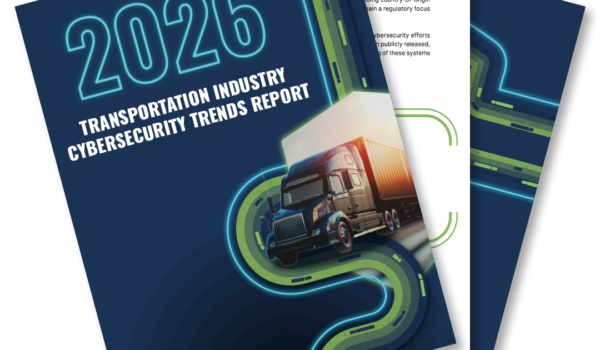In the constantly evolving cybersecurity landscape, ransomware has moved beyond isolated, high-value extortion events and into an industrialized model of cybercrime.
One of the most dangerous evolutions is Ransomware as a Service (RaaS). RaaS is a decentralized criminal business model that closely mimics the legitimate Software as a Service (SaaS) industry.
Unlike traditional ransomware gangs that plan, execute, and profit from their own attacks, RaaS platforms instead “license” their ransomware tools to “affiliates.” This enables even rather unskilled cybercriminals or “script-kiddies” to carry out devastating attacks.
For trucking companies, brokers, and third-party vendors in the transportation industry, this shift introduces a much broader and less predictable threat landscape. Victim selection is no longer limited to major corporations, government, or geopolitical targets. Instead, the scale and efficiency of RaaS operations means that small fleets, regional carriers, and brokerages of all sizes are just as likely to find themselves in the crosshairs.
To help the industry better understand and defend against these evolving threats, the National Motor Freight Traffic Association, Inc. (NMFTA)™ has released two new resources:
- A recorded webinar featuring expert insights into how RaaS is affecting transportation and supply chain operations. Access the recording here.
- An in-depth whitepaper developed by NMFTA’s cybersecurity team, breaking down the business model behind RaaS and what it means for carriers, brokers, and vendors. Access the whitepaper here.
These resources shed light on how RaaS is more than just malicious code—it is about infrastructure, talent acquisition, and scalability. The operators behind these platforms offer ready-made ransomware kits, user dashboards for tracking campaigns, payment collection tools, and even customer service support for their affiliates. In return, they profit from licensing and tiered subscription fees, as well as commissions based on a share of any ransom payments.
This model has served to dramatically lower the bar of entry for wannabe cybercriminals. RaaS affiliates do not need to know how to craft their own malware or manage their own infrastructure. Often, even the skills required for successful initial penetration of target networks are no longer needed, as stolen credentials and persistent access can be acquired from clandestine marketplaces and access brokers on the so-called dark web. As a result, the number of potential attackers has expanded exponentially. Targeting decisions are left to the affiliates, many of whom pursue opportunities based on ease of access rather than strategic value.
For defenders in the transportation sector, this shift has translated into a significant increase in an increase in attack surface, the attack frequency, and the diversity of victims. RaaS affiliates cast wide nets—and companies who qualify as “low-hanging fruit” due to inadequate patching, weak credential management practices, poor end-user awareness training, lack of multi-factor authentication (MFA), or any other basic cybersecurity hygiene oversights quickly become easy prey.
It may be tempting to view RaaS through the same lens as traditional ransomware threat actors. Both use encryption, data exfiltration, and extortion as pressure tactics. However, the structural differences between these two types of threats are significant and have a major impact on the operational consequences.
- Motivation and Focus: Traditional ransomware groups are primarily motivated by ideology. They pursue specifically selected high-value targets, often with political, economic, or strategic significance. RaaS affiliates by contrast are motivated purely by opportunistic financial gain. Their victims often include small to mid-sized businesses, especially those with weak cybersecurity postures.
- Division of Labor: RaaS separates malware development and infrastructure management from attack execution. The core technical team consists of employees and independent contractors who focus on malware development, scaling the service and evading detection, while affiliates handle target selection and exploitation campaigns. Ransom negotiations and payments may be handled by either the RaaS provider or the affiliate, depending on the specific RaaS platform.
- Attack Sophistication: While many affiliates lack advanced technical skills—some fall squarely into the script-kiddie camp—the tools that they wield are often cutting-edge, leveraging zero-day exploits, advanced persistence techniques and defense evasion.
This division of responsibilities, the commoditization of high-grade malware, and the resulting explosive expansion of the number of cybercriminals posing a credible risk to organizations means that all companies, regardless of size or notoriety are now vulnerable to the threat of a RaaS attack.
While trucking and logistics firms may not have always been considered “crown jewel” targets for traditional ransomware gangs, they are more and more often targeted by RaaS affiliates. The combination of high operational uptime requirements, complex supplier networks and often underfunded or overstretched IT teams make many companies in the transportation sector juicy targets for RaaS affiliates.
With increasing frequency, RaaS affiliates are targeting trucking companies, brokers, warehouses, and others across the supply chain. These victims suffer data theft, operational disruptions, leaks of sensitive files—from HR records (i.e. CDL numbers, drug test results, etc.) through corporate contracts and internal communications, not to mention significant financial losses. These victims have ranged from small, regional operations to international corporations which further highlights the indiscriminate nature of the targeting used by RaaS affiliates.
To combat this rising tide of cybercrime, organizations in the transportation sector need to think beyond cyber insurance and incident response plans. Mitigating the risk of the RaaS threat requires attention across multiple fronts:
- Creating a Security-Focused Culture: RaaS attacks often begin with social engineering, phishing, or credential compromise. Training employees in social engineering awareness and good cyber-hygiene, enforcing MFA, and building a culture of vigilance are critical.
- Threat Detection and Access Controls: RaaS attacks often rely on lateral movement after initial access. Limiting administrative privileges, ensuring network segmentation, network and endpoint monitoring, and defense in depth across the organization can serve to limit the “blast radius” and slow the spread of a RaaS attack, giving the organization time to detect, contain, and respond to the attack.
- Asset Inventory and Patch Management: Unpatched systems are a well-known RaaS entry points. Organizations must maintain complete, up-to-date inventories of all assets. All assets, particularly internet-facing assets, must be patched promptly for known security vulnerabilities.
- Disaster Recovery and Business Continuity Planning: Operate on the assumption that a compromise will occur. Ensuring immutable, encrypted offline backups are maintained and regularly tested, maintaining available environments or assets into which to deploy those backups when needed, and creating an organization-wide business continuity plan are all non-negotiables.
Ransomware as a Service has fundamentally changed the economics and risk calculus of cybercrime. Across the transportation sector this means that no company is too small or too obscure to be targeted. The decentralization of ransomware through RaaS ensures that every single internet-facing system is a potential doorway for cybercriminals, and every single company is a potential victim.
It is important for business leaders to understand that RaaS is not a passing trend—it is a criminal business model with significant and sustained momentum. The only effective defense is proactive investment in cybersecurity, persistent training, and executive engagement in a comprehensive security strategy. In today’s threat environment, cybersecurity is not an IT issue—it is an operational imperative.






